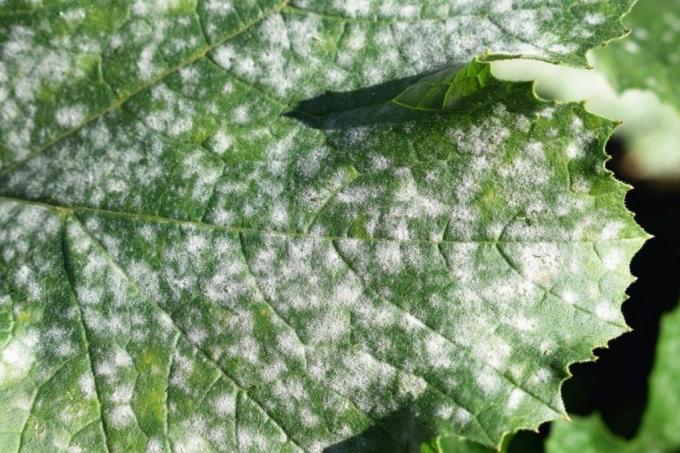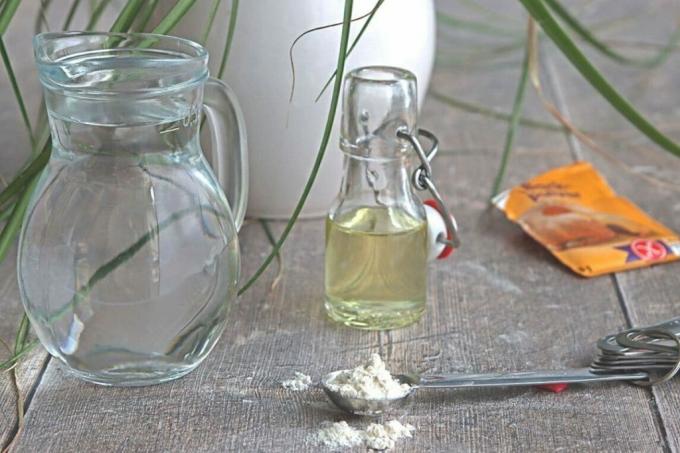
table of contents
- Recognize powdery mildew
- This is how baking powder works against powdery mildew
- Use baking powder against powdery mildew
- Prevention instead of fighting
- frequently asked Questions
Powdery mildew is feared by all hobby gardeners because it damages plants enormously and can lead to their death. Many home remedies are recommended for the fungal disease. Does the often mentioned baking powder actually have an effect against powdery mildew?
In a nutshell
- Powdery mildew is a widespread fungal disease that affects the leaves and flowers of plants
- Many home remedies are used to combat it
- The baking soda contained in many baking powders works against the causes of powdery mildew
- Effect is based on an increase in the pH value
- Mixture with rapeseed oil adds lecithins from rapeseed oil to the effect
Recognize powdery mildew
There is no such thing as one powdery mildew. Instead, the name is a collective term for various diseases caused by fungi. The origin of the name is the white mushroom lawn, which initially covers the leaves and is strongly reminiscent of dusting with flour. The so-called “real powdery mildew types” are caused by ascomycota mushrooms, all of which show the same behavior with regard to the use of baking powder.

Damage caused by "powdery mildew"
- forms mainly when it is warm and dry
- white, later brownish coating on the upper side of the leaves / flowers
- wipeable
- withered leaves, stunted flowers
This is how baking powder works against powdery mildew
Normal raising agents from the domestic kitchen contain binders and carriers, especially baking soda or sodium hydrogen carbonate, chemically also as NaHCO3 known. When reacting with water, the substance mainly develops carbon dioxide or CO for short2 and when it escapes, it causes an alkaline reaction. The pH in the area of the baking soda rises. Correctly applied to plants, the baking soda-water mixture removes the sac fungi that affect a certain area depend on the pH value on the leaf surfaces, i.e. their livelihood, and let them slowly but effectively die.
Tip: Since raising agents cannot be used in their pure form anyway, they are dependent on other carrier substances. The spectrum of activity can be expanded by choosing the right carrier.
Use baking powder against powdery mildew
To combat powdery mildew, the home remedy must be baking powder or Baking soda permanently adhere to the leaf. A mixture with cooking oil and water in the following dosage is recommended for this purpose:

- 1 packet of baking powder
- approx. 20 milliliters of cooking oil
- 1 liter of water
Thanks to the oil, the mixture adheres well to the plants, while the water enables it to be spread evenly and at the same time provides the moisture to initiate the chemical reaction.
Tip: Use canola oil to make the mixture more effective. This type of oil contains lecithins, which are also used in pesticides and which also combat the growth of fungi.
The resulting emulsion can now be used as follows:
- Shake well immediately before use due to poor miscibility of oil and water
- Spray the mixture generously
- Repeat the process regularly after two weeks at the latest
- Renew the order after rain or excessive condensation
Prevention instead of fighting
Despite its proven effectiveness, sodium hydrogen carbonate takes a long time to get a mildew infestation under control. However, the remedy can also be used preventively in the same form. The advantage here is that sporadic fungi are killed at an early stage and so do not have the opportunity to develop colonies worth mentioning from the outset.

To be able to prevent it, it is important to know which plants are particularly susceptible to powdery mildew. These include:
- Roses
- Apple trees
- Gooseberries
- Grapevines
- Cucumber
- zucchini
- pumpkin
- tomatoes
- Oak trees
frequently asked Questions
You have probably used the wrong raising agent. In addition to agents containing soda, there are numerous alternatives, for example those based on tartar. These show no effect whatsoever against the fungal attack.
Of course, the effectiveness does not stop immediately if the mixing ratio is different. Too much oil, however, causes oil droplets to lock in the baking soda and prevent the reaction. Too much baking soda often leads to the formation of lumps that do not adhere to the leaves due to their own weight.
In contrast to the “real” variant, the causes of “downy mildew” are not tubular, but egg fungi. These types of fungus are far more resistant to changes in the pH value and are therefore only combated to a limited extent by the sodium-oil-water mixture that is produced.



